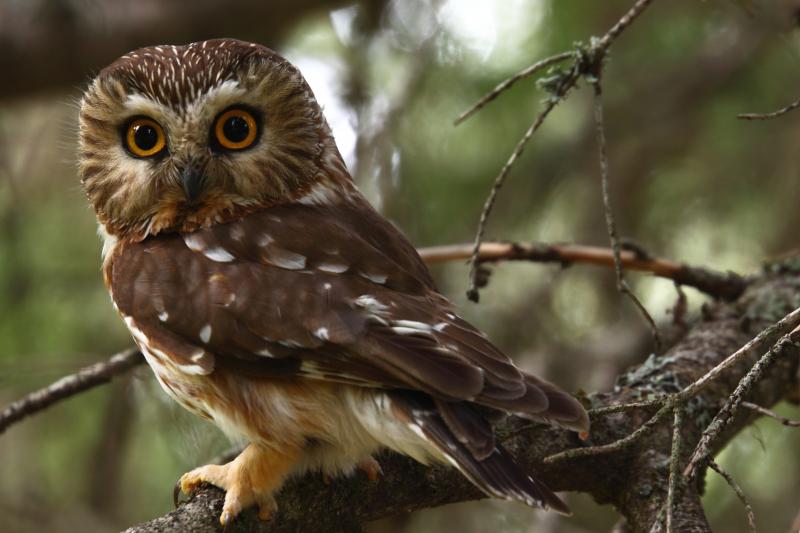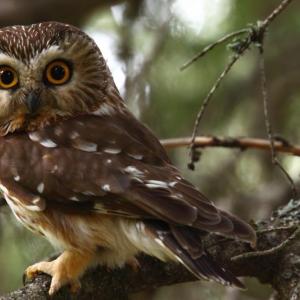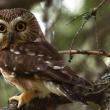A Backyard Owl Surprise
A friend of ours has become seriously consumed with learning and studying bird sounds. He began recording them regularly with his iPhone this past fall and then learned how to make sonagrams of the calls to study them further. When we chatted about the question of whether he might have owls inhabiting the extensive woodland behind his house, he began doing some limited recording at night with his phone.
It wasn’t long before he wanted to get more extensive night-long recordings and so we lent him one of the tiny AudioMoth automated sound recording units that we wrote about this past summer.
The avian discoveries from his focused sound recording efforts have been amazing!
Within days of beginning his full night-time recordings, he discovered that he has a northern saw-whet owl right behind his house. There on his recordings were the telltale repeated tooting whistles, like the warning sound of a distant, backing-up truck, except going on longer and at intervals throughout the night.
Saw-whet owls are the tiniest of Maine’s resident owls, roughly the size of a robin. They are streaked with brown below and have yellow eyes and a black bill. Their known breeding range extends from southern Canada south to the upper elevations of the Appalachians of Tennessee in the East, and in the West, south even into Mexico.
Despite the fact that most Mainers (and many birders) will go a lifetime without ever seeing one, they are thought to be fairly widespread and relatively common. We read in the recently published “Birds of Maine” that our old friend, the late Norm Famous once counted 49 calling males in a long night of owl surveying across a part of eastern Maine.
We are probably more like the majority of birders who consider ourselves lucky if we hear just a single saw-whet owl tooting away in any given year without spending significant time searching for them in nocturnal forays. And we can count on one hand the number of saw-whet owls we have been fortunate enough to actually see in the wild.
So that’s why it’s so cool that our friend has found a saw-whet owl in his backyard that is blessing him with night after night of wonderful sounds. Not only is he getting recordings of the more well-known repeated tooting song of the male saw-whet owl but he is also learning and recording all sorts of lesser-known calls of the species. He has been sending over sound clips to us that are expanding our own familiarity with the full range of sounds these little owls can make. Some of them are whines and others short, almost barking-like sounds. It’s fun to imagine what the birds are doing out there in the dark!
So far in January and early February, there have already been about 20 singing saw-whet owls noted around the state, according to the eBird database.
Maybe you have one in your backyard too?
If so, perhaps the timing will be such that you can add it to the Great Backyard Bird Count (GBBC) database. The GBBC is happening Feb 12-15 - mark your calendars, saw-whet or not!
You can listen to some of our friend’s recordings here:
Saw-whet Owl toot series: https://soundcloud.com/birdwells/saw-whet-owl-rapid-toot-series-2-1-21-0114-am-west-gardiner-me
Jeffrey V. Wells, Ph.D., is a Fellow of the Cornell Lab of Ornithology and Vice President of Boreal Conservation for National Audubon. Dr. Wells is one of the nation's leading bird experts and conservation biologists and author of the “Birder’s Conservation Handbook.” His grandfather, the late John Chase, was a columnist for the Boothbay Register for many years. Allison Childs Wells, formerly of the Cornell Lab of Ornithology, is a senior director at the Natural Resources Council of Maine, a nonprofit membership organization working statewide to protect the nature of Maine. Both are widely published natural history writers and are the authors of the popular books, “Maine’s Favorite Birds” (Tilbury House) and “Birds of Aruba, Bonaire, and Curaçao: A Site and Field Guide,” (Cornell University Press).
Event Date
Address
United States

























